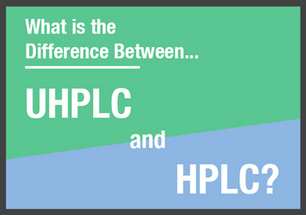Posted by Chrom Tech on 20th Nov 2025
What Is the Difference Between UHPLC and HPLC?
The two main differences between UHPLC and HPLC lie in their maximum system pressure ratings and the particle size used in the HPLC column stationary phase. Understanding these distinctions is key to choosing the right chromatographic system for your lab’s performance and analytical goals.
What Is HPLC?
High-Performance Liquid Chromatography (HPLC) is a widely used analytical technique that separates complex mixtures into their individual components. A liquid mobile phase carries the sample through a column packed with small stationary phase particles. The HPLC pump drives the mobile phase through the column at high pressure, allowing compounds to separate based on their chemical interactions with the stationary phase.
Compounds that interact more strongly with the stationary phase elute later (show higher retention), while less retentive compounds pass through quickly. Once separated, analytes are detected and recorded as peaks on a chromatogram.
Over the years, improvements in HPLC fittings, connectors, and stationary phase chemistry have enabled higher pressures and smaller particle sizes—leading to faster, more efficient separations and the evolution of advanced chromatographic systems like UHPLC.
What Is UHPLC?
Ultra High-Performance Liquid Chromatography (UHPLC)—also known as Ultra High-Pressure Liquid Chromatography—builds upon HPLC technology by operating at much higher pressures, often up to 20,000 psi (1,300 bar), compared to HPLC’s typical limit of 6,000 psi (400 bar). This higher pressure allows the use of sub-2 µm particle size columns, which deliver improved efficiency, resolution, and analysis speed.
Because UHPLC systems generate significantly greater backpressure, it’s essential to use compatible high-pressure fittings and connectors to ensure safe and leak-free operation.
Key Differences Between HPLC and UHPLC
- Pressure Capability: UHPLC operates at up to 20,000 psi, whereas HPLC typically maxes out at 6,000 psi.
- Particle Size: UHPLC columns use smaller stationary phase particles (sub-2 µm), increasing efficiency and resolution.
- Analysis Speed: UHPLC achieves faster run times due to higher flow rates and shorter columns.
- System Design: UHPLC systems are built with low dead-volume components to minimize dispersion.
How UHPLC and HPLC Separate Mixtures
Both UHPLC and HPLC systems separate compounds based on their interactions with stationary and mobile phases under high pressure. Smaller column particles in UHPLC provide a larger surface area, resulting in enhanced separation and reduced diffusion paths.
Solid Core Particle Design
Modern column technology often uses solid core particles—a dense inner core surrounded by a thin porous shell—to improve performance. This design shortens diffusion paths, increases efficiency, and enables faster analyses without sacrificing resolution.
UHPLC and HPLC systems using solid core technology provide:
- Shorter analysis times
- Improved peak resolution
- Enhanced reproducibility and consistency across runs
UHPLC and HPLC Fittings
Proper connections are critical in both UHPLC and HPLC systems to prevent leaks and maintain system performance. Before the pump, low-pressure flangeless fittings (¼-28 flat-bottom connections) are sufficient. After the pump, the system enters the high-pressure region, where durable components like Idex Fittings are essential to withstand the increased backpressure caused by the column.

Applications of HPLC and UHPLC
Both HPLC and UHPLC are indispensable tools across scientific and industrial disciplines:
- Legal and Forensic Testing: Detection of drugs and controlled substances.
- Pharmaceutical Development: Drug purity assessment and quality control.
- Medical Diagnostics: Measurement of biological markers such as vitamins or hormones.
- Research and Development: High-resolution analysis for biochemistry and molecular biology.
- LC-MS Integration: UHPLC and HPLC seamlessly pair with mass spectrometry (LC-MS) for molecular identification and quantification.

How HPLC and UHPLC Have Evolved
Modern chromatography continues to evolve through innovations in column particle design, system architecture, and detector sensitivity. UHPLC’s adoption of sub-2 µm particles has redefined chromatographic performance—delivering faster, more efficient separations with greater reproducibility. Meanwhile, HPLC remains a trusted, cost-effective option for routine analyses and laboratories not requiring extreme pressure capabilities.
Conclusion
While both UHPLC and HPLC serve the same fundamental purpose—to separate, identify, and quantify components in a sample—their operational differences make each suited to different analytical needs. UHPLC offers unmatched speed and resolution under extreme pressures, while HPLC remains the reliable workhorse of analytical chemistry.
Whether you’re optimizing for throughput or robustness, Chrom Tech’s range of HPLC and UHPLC columns and fittings provides the precision and durability you need to advance your chromatography workflows.
Frequently Asked Questions About UHPLC vs. HPLC
What is the main difference between UHPLC and HPLC?
The main differences are system pressure and column particle size. UHPLC operates at much higher pressures (up to 20,000 psi) and uses smaller particles (<2 µm), leading to faster, higher-resolution separations than traditional HPLC.
Can UHPLC columns be used in HPLC systems?
Not typically. UHPLC columns create more backpressure than HPLC systems are designed to handle, which may exceed their pressure limits and cause damage.
Which technique is best for routine analysis?
HPLC remains ideal for most routine and QC applications due to its cost-effectiveness and compatibility with a wide range of analytical workflows. UHPLC is best suited for high-throughput or high-resolution applications where speed and precision are critical.

